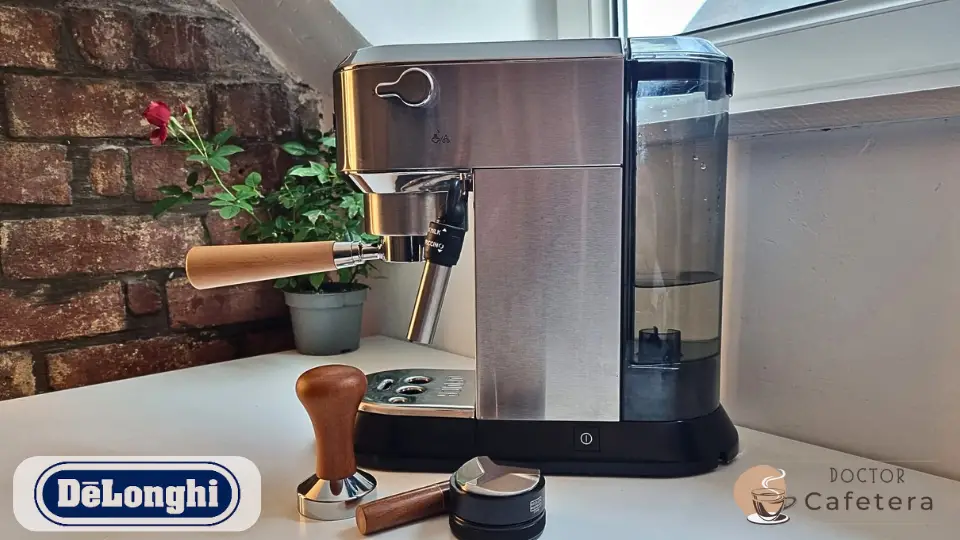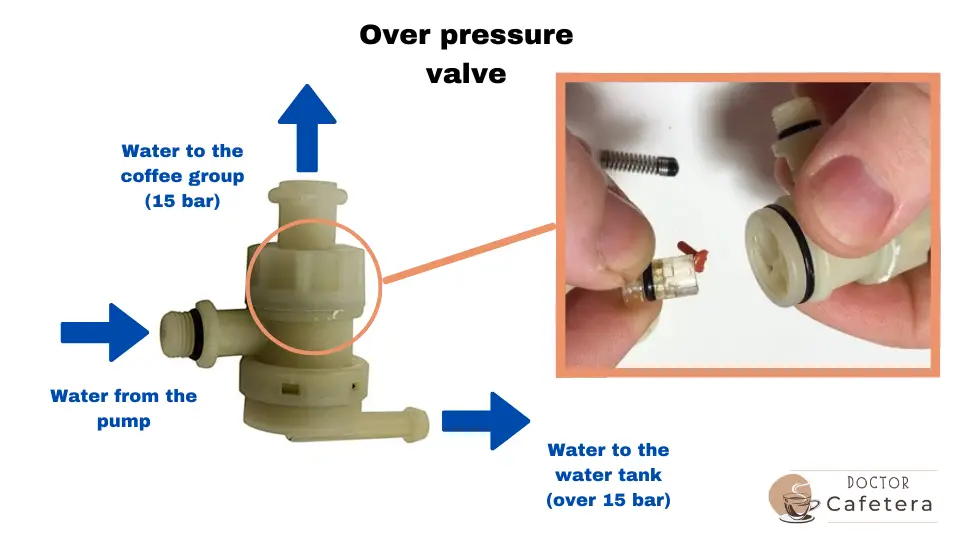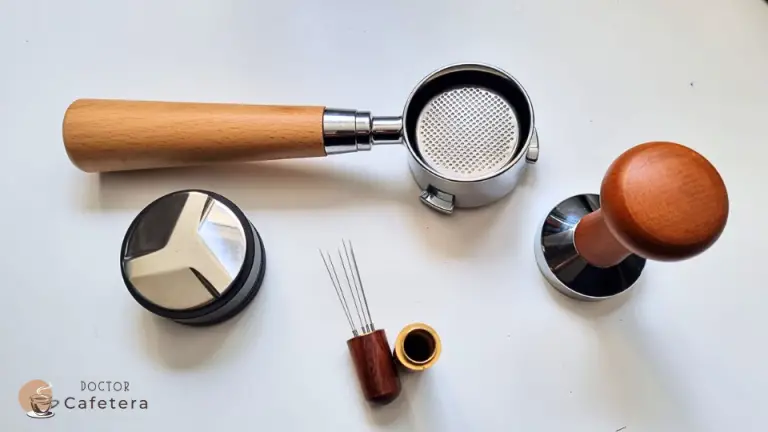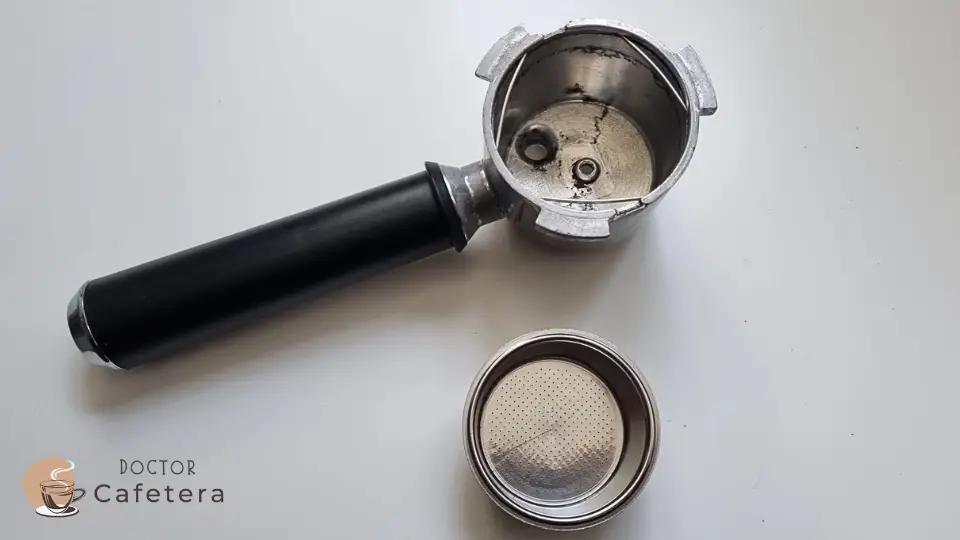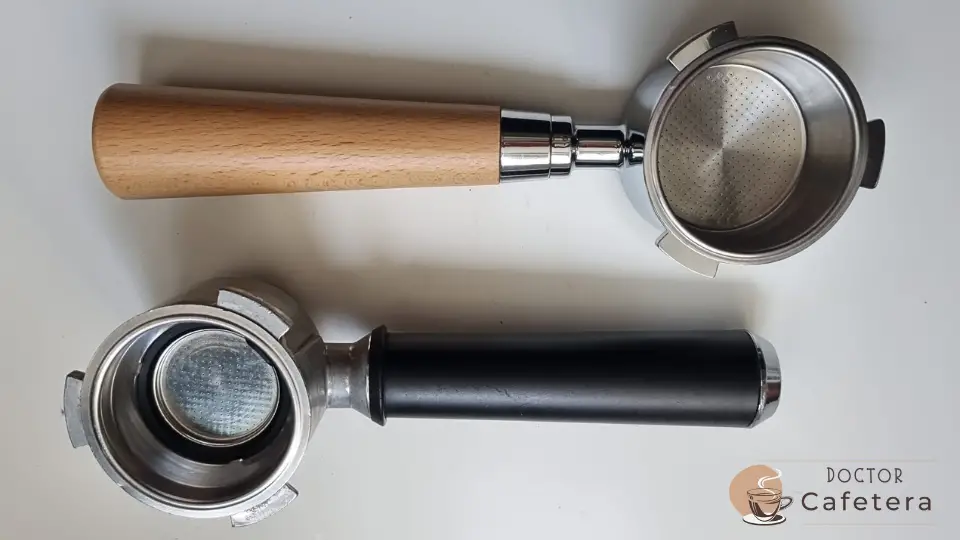The De’Longhi Dedica is one of the most well-known home espresso machines on the market, making it a great choice for those just getting started in the espresso world. Thanks to its pressurized filter, it has gained popularity for its elegant design and ability to brew quality coffee with minimal effort.
However, many of us who use this machine have, at some point, encountered issues with the infamous pressurized filter, directly impacting the quality of our espresso. In this article, I will highlight the most common problems with the filter and provide solutions based on my experience with the DeLonghi Dedica.
How De’Longhi Dedica pressurized filter works
As mentioned, the De’Longhi Dedica espresso machine is renowned for its exceptional performance in effortlessly brewing high-quality espresso. To fully grasp how the pressurized filter works, it’s essential to break down the key elements involved in the extraction process:
1. 15-bar pressure
The De’Longhi Dedica features a 15-bar pressure pump, while a professional espresso machine extracts coffee at 9 bars of pressure.
⚠️ Attention: The previous statement mentions two different pressures. On the one hand, there is the pump pressure (static pressure); on the other, there is the water pressure through the coffee grounds (dynamic pressure). Therefore, the 15 bars of pump pressure do not mean coffee is extracted at that pressure.
All espresso machines are equipped with a component known as the Over Pressure Valve (OPV). This small valve redirects water back to the reservoir when a specific pressure level is reached, helping to control the pressure applied to the coffee during extraction.
| Coffee maker type | Static pressure | Dynamic pressure |
| DeLonghi Dedica | 15 bar | 8-11 bar |
| Professional espresso machine | 10 -10.5 bar | 9 bar |
So, the pressure ultimately depends not on the pump but on the overpressure valve and the resistance of its internal spring.
The issue is that the DeLonghi Dedica does not have a high-quality OPV valve so the pressure can vary from 8 to 11 bars, depending on the coffee machine.
2. The pressurized filter
The Dedica’s pressurized filter is a critical component influencing coffee quality, especially if you’re not an expert in this area. The filter opposes the water flow rather than the coffee puck.
There are different pressurized filters, but the one in the DeLonghi Dedica consists of two parts. On the one hand, there’s the basket with a tiny hole in the center, and on the other hand, a perforated screen with a rubber edge that fits over the bottom of the basket.
Inner screen
Inside the pressurized filter, a tab can be removed for cleaning. Sometimes, its function may be confused, as it resembles a regular filter. However, as one might assume, its primary purpose is not to regulate water pressure. Its main goal is to maintain and evenly compact the ground coffee, allowing water to filter through it in a controlled manner.
Note: Other models of pressurized filters are known as “double-wall” because the removable screen in the DeLonghi Dedica is constructed as a single unit over the bottom hole, creating a small chamber between the upper and lower walls.
Plastic nozzle
When examining the inside of the portafilter, you’ll notice the presence of a black plastic component, which serves a dual purpose: firstly, to evenly distribute the extracted coffee, and secondly, to regulate the flow rate into the cup, ensuring it flows with the right force and optimal speed, thus contributing to the quality of extraction and crema production.
3. The crema
The authenticity of the crema formed in espresso made with a pressurized filter is often questioned. While this could be the subject of an entire article, I must say that the crema created by a pressurized filter is just as valid as that created with a non-pressurized one.
The classic crema (with a non-pressurized filter) results from the right pressure, proper grinding, and even distribution of the ground coffee. Crema serves as a hallmark of quality and authenticity in a well-prepared espresso.
Issues with the pressurized filter
The De’Longhi Dedica is an espresso machine that promises perfection in every cup. However, at times, you may encounter obstacles that affect its ability to prepare coffee or the necessary pressure for optimal extraction. Here, I will explain how to address these issues so you can enjoy your favorite coffee without any hitches.
My De’Longhi Dedica doesn’t brew coffee
If your De’Longhi Dedica espresso machine isn’t preparing coffee, it’s essential to understand that this can be due to different factors. Below, I’ll show you the possible causes and solutions for this inconvenience:
Cause 1. Incorrect amount of coffee
A common issue can be using an incorrect amount of coffee in the portafilter. For example, too much coffee can increase resistance and make it difficult for water to flow through the ground coffee. Ensure you measure the correct amount of coffee and adjust as needed.
7 grams for the single basket and 14 grams for the double basket
Understanding the design and size of the baskets in a pressurized filter is crucial. The single basket has a specific capacity of 7 grams of coffee, while the double basket can hold up to 14 grams.
⚠️ Exceeding these amounts in either case can lead to blockages in the filter or malfunction of your coffee maker.
When buying coffee at the supermarket for your coffee maker, I recommend choosing pre-ground coffee specifically labeled for espresso. Typically, these types of coffee have a coarser grind than what is required in a traditional espresso machine. The coffee maker should work smoothly if you place it in the basket and tamp it down correctly.
➡️ If the coffee maker still doesn’t brew coffee correctly after this, the issue is likely with the overpressure valve, as the amount of coffee and grind is suitable for a successful espresso preparation process.
Cause 2. Wrong coffee grinding
When the grind is too fine, the coffee becomes overly compacted in the filter, making it difficult for water to flow through. In this case, the coffee could “take over” the filter’s job, as the main resistance comes from it. Contrarily, if the grind is coarse, the pressurized filter will perform at its best. Its design is intended to overcome this resistance and ensure that water passes through the coffee evenly.
Pressurized filters are designed for people who buy pre-ground coffee, with a slightly coarser grind than a non-pressurized espresso machine. Therefore, you should always grind a bit coarser.
Cause 3. Wrong tamping
How you tamp the coffee in the portafilter also plays a significant role. Over-tamping the coffee can block the water flow and prevent the espresso from being extracted properly. On the other hand, insufficient tamping can allow water to flow too quickly, clogging the filter hole.
Find the right balance when tamping the coffee to ensure even extraction.
✅ These are the accessories that I use myself and recommend to you:
Cause 4. Quick preparation and weak coffee
A common issue that can lead to very watery and weak coffee is the use of a too-coarse grind. When using a pressurized filter, the coffee extraction task requires little effort; however, a too-coarse grind can hinder efficient extraction, resulting in weak coffee.
This effect also occurs when the coffee is too old in terms of roast. Over time, coffee can lose the essential gases for good flavor and optimal extraction. When this happens, the coffee can become tasteless and lack the freshness and body expected in a cup of espresso.
Cause 5. Use of “sugared roasted” coffee
Sugared roasted coffee is roasted with added sugar, resulting in its characteristic glossy black appearance. However, this particularity can hurt the performance of the pressurized filter, hindering its efficiency and obstructing the coffee flow.
It’s important to note that the pressurized filter has a small hole, which means the main resistance comes from it. When you use too much coffee or too fine a grind, the coffee becomes the primary barrier to water flow, and the filter hole becomes secondary in terms of resistance.
Adjusting these four factors (quantity, grind, tamping, and preparation) will help you resolve the issue of the De’Longhi Dedica not brewing coffee and allow you to enjoy high-quality espresso at home.
De’Longhi Dedica coffee maker with low pressure
If, after checking and adjusting the amount of coffee, grind, and tamping, you still experience no coffee flow or low water pressure in your De’Longhi Dedica coffee maker, the issue may be related to the overpressure valve.
The overpressure valve is a vital component that regulates the pressure inside the coffee maker, ensuring proper espresso extraction.
However, in some cases, the overpressure valve may experience issues, resulting in low water pressure during espresso extraction. I recommend reading this article, where I explain in more detail how to address this problem.
Improvements to the pressurized filter of your De’Longhi Dedica coffee maker
If you’re looking to optimize the performance of your De’Longhi Dedica, there are several improvements you can consider to enhance your coffee brewing experience. Here are the ones related to the pressurized filter:
1. Switch to an unpressurized basket
To improve the filtration system of your coffee maker, one of the first steps I recommend is replacing the basket with an unpressurized 51mm version. To do this, remove the plastic piece from the bottom of the portafilter, although you will be left with a hole in the bottom where the screw used to be.
When brewing coffee, grind, distribute, and tamp the coffee evenly in the unpressurized basket. This process is crucial to ensure a balanced, consistent, and channel-free extraction.
Remember that if you use the original portafilter, you won’t be able to evaluate the process visually. Instead, you’ll need to rely on taste, extraction time, and the amount of coffee extracted (ratio) to determine the quality of your espresso.
Note: A 1:2 or 1:2.5 ratio with an extraction time of 25-30 seconds is considered standard, but with a De’Longhi Dedica, this ratio may vary due to its unstable extraction pressure.
2. Erwägen Sie einen bodenlosen Portafilter
Eine andere Möglichkeit ist der Wechsel zu einem bodenlosen Portafilter. Beachten Sie jedoch, dass diese Methode mehr Wissen und Können erfordert. Die Qualität Ihrer Tasse Kaffee (und die Sauberkeit Ihres Hemdes) hängt hier weitgehend vom Mahlgrad, der Kaffeesorte und der verwendeten Technik ab.
Denken Sie daran, dass die De’Longhi Dedica aufgrund ihres unregelmäßigen Drucks zu Rinnenbildung neigt. Daher ist es wichtig, den richtigen Mahlgrad zu verwenden und den Kaffee-Puck richtig zuzubereiten.
Furthermore, at this point, I recommend using dark roast coffee, as they are easier to extract, and there’s no need to grind too fine, as finer grinds are more prone to channeling.
Understanding the ideal ratio is crucial, and experimenting is key to achieving an exceptional cup. Remember that the path to the perfect espresso may require practice and adjustments to find the ideal balance for your preferences.
Conclusion
As I delve into the intricacies of the De’Longhi Dedica espresso machine, from its basic operation to troubleshooting and possible improvements, it becomes clear to me that espresso preparation is an art that demands attention to every detail.
These tips are designed to help you unlock the full potential of your De’Longhi Dedica and turn each cup into a masterpiece. With practice and patience, you can enjoy exceptional quality espresso that satisfies your senses and elevates your love for coffee.

